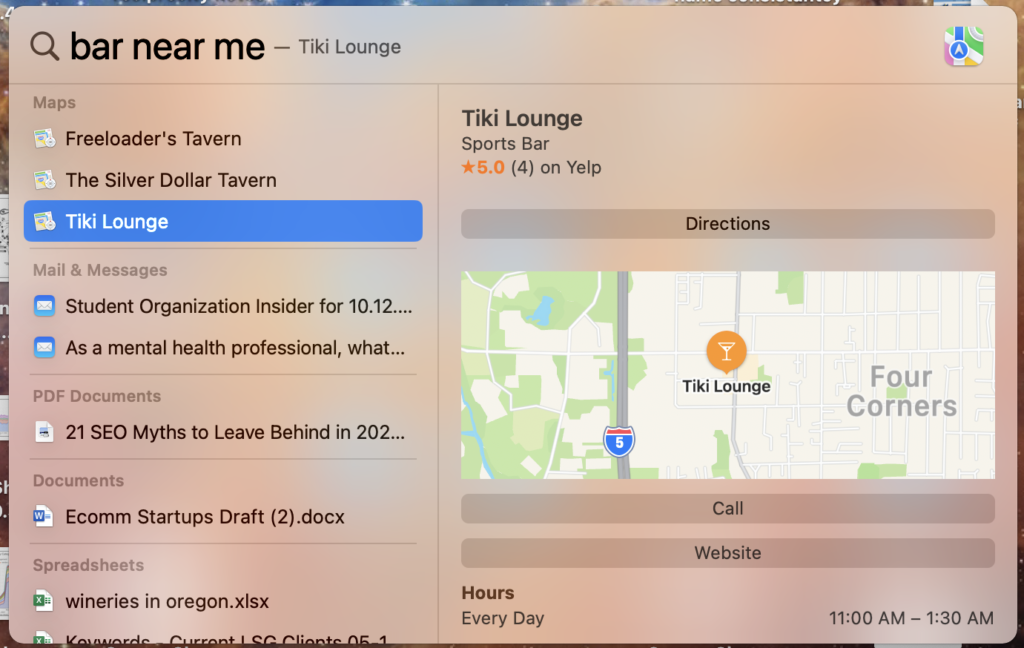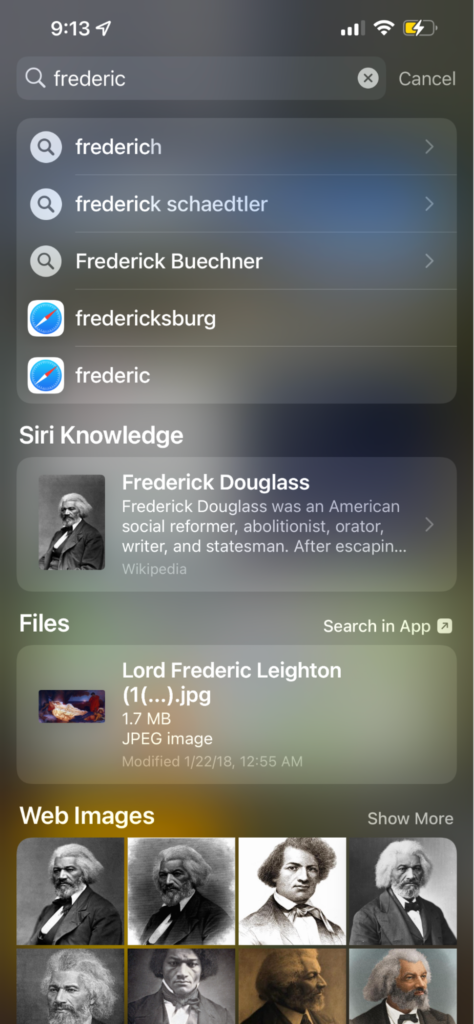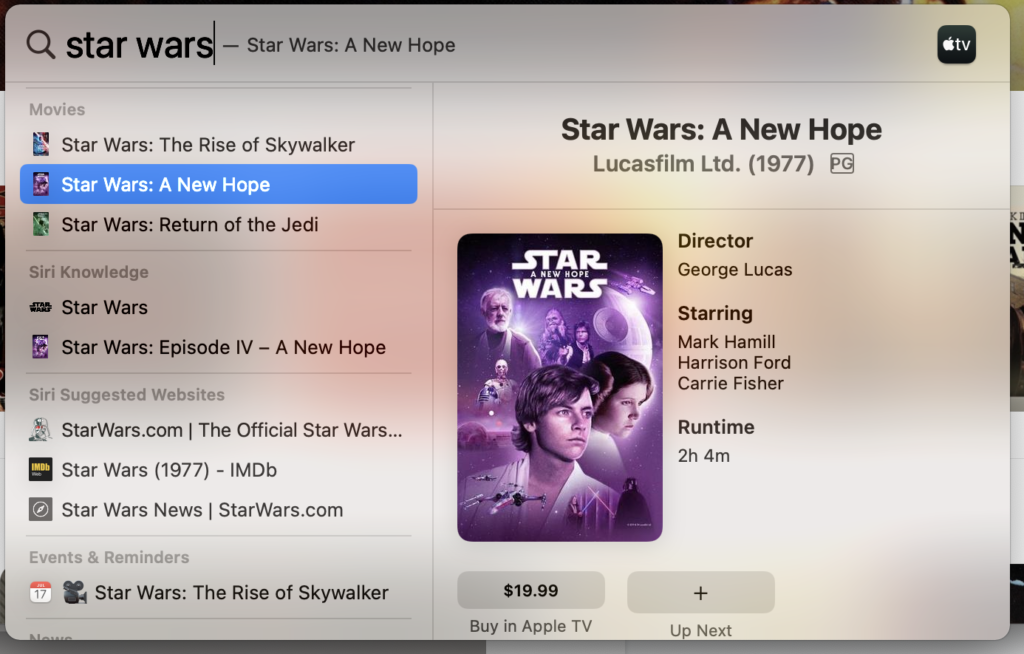There have been a lot of tweets and chatter about Apple launching a search engine and SEO Twitter is all abuzz about whether or not Apple will create a new search engine and what it will look like or when it will launch. The thing is, it’s already out there and many of us use it every day.
Spotlight Search has been available on both iOS and MacOS since 2005 (source). If you have a Mac, just click on the magnifying glass at the top of the screen and search. Depending on your preferences set up, one of the results options you’ll get is “Siri Suggested Websites”.
Where Spotlight Gets its Data for Search Results
While we don’t have complete info on how Siri gets its results, but it’s likely that it compiles data from:
- Safari browser usage
- Applebot web crawls
- Apple Maps
- Feeds from trusted partners such as Wolfram Alpha, Wikipedia, Youtube, etc.
- Other Apple Apps
The data is taken from these sources to produce several different search result types which can include:
Siri Suggested Websites
Siri Suggested Websites is an optional feature in Safari that serves up auto-completed suggestions based on what the user starts typing into the browser’s search bar.
Where the data comes from: Siri suggestions in Safari take advantage of your browsing history, bookmarks, and open websites but it can also use your location, topics of interest, suggestions you have selected, apps you use, and related device usage data to Apple.
Apple Maps
Apple Maps is the default GPS and web mapping service system of iOS, iPadOS, macOS, and watchOS. When Spotlight thinks queries have local intent you’ll likely see a map result.

Where the data comes from: Historically Apple has used TomTom, OpenStreetMap, Weather Channel, and others as data sources, as far back as its launch in 2012, because those services still provide data in certain markets but is building it own framework for US navigation. We estimate that their are likely at least 71 million Apple Maps users in the US alone.
Siri Knowledge
Siri Knowledge is a feature that uses a combination of data automatically drawn from all the built-in apps on your Apple device including Mail, Messages, Maps, and Safari.

Where the data comes from: As you can see with this result they are using 3rd party trusted partners like Wikipedia to populate their search results within Spotlight.
Apple Music
Spotlight will also show relevant Music files in search results, especially if they are files that are already in your Apple Music library while the Apple Music app also generates additional results.
Where the data comes from: Files from your device in the case of Spotlight. However, when you subscribe to Apple Music it collects information about how you use Apple Music in order to tailor features to your musical tastes.
These features include Listen Now, where you see albums and playlists picked for you, and Radio, which plays selections from your favorite artists and genres.
They also use this information so that they can contact you by email and push notification about upcoming releases, new artists, and other happenings on Apple Music that you may like.
For most customers, they retain this data for at least a 10-year retention period, but in regions such as China that period can be 30 years.
Apple News
Searches for public figures, events, or topical subjects can also display news articles.
Where the data comes from: News results are drawn from the web and are typically aggregated in Apple News. The Apple News app works by pulling in news stories from the web through various syndication feeds (Atom and RSS) or from news publishing partners through the JSON descriptive Apple News Format. News is fetched from publisher’s websites through the AppleBot web crawler bot. The bot fetches feeds, as well as web pages and images for the Apple News service.
Apple TV
Additionally, Spotlight SERPs will contain movies and tv shows from Apple TV.

Where the data comes from: Apple collects information about your purchases, downloads, activity in the Apple TV app, the content you watch, and where you watch it in the Apple TV app and in connected apps on any of your supported devices. We use this information to provide the service and to improve the Apple TV app for you and others.
Apple uses information about the movies and TV shows you purchase and download to offer advertising to ensure that Ads in the App Store, Apple News, and Stocks, where available, are relevant to you.
Bernstein analyst Toni Sacconaghi estimated that Apple had ad revenue of about $4 billion in calendar 2021, up from an estimated $300 million in 2017. The bulk of this is from the ads in the App Store with a lesser amount from display ads in Apple News.
Related Searches
Exactly as it sounds, related searches show you associated searches from your Finder or the Web.
Where the data comes from: The data for these results is likely drawn from your Safari browser usage like your browsing history, bookmarks, open websites, etc.
Of course, these aren’t the only types of search results categories you may see in Spotlight. For example, you could also see local files like Events & Reminders, Spreadsheets, Documents, etc. but these are some of the major categories we’ll be focusing on.
How does Applebot work?
Earlier, we mentioned that it’s likely Apple is using Applebot web crawls as a resource for knowing what to show users so it begs the questions:
What is Applebot exactly? And, how does it work?
Applebot is the web crawler for Apple. Products like Siri and Spotlight Suggestions use Applebot. Basically, this is how Apple indexes the content of websites all across the Internet so that those websites can appear in search results.
According to Apple, Apple Search may take the following into account when ranking web search results:
- Aggregated user engagement with search results
- Relevancy and matching of search terms to webpage topics and content
- Number and quality of links from other pages on the web
- User location-based signals (approximate data)
- Webpage design characteristics
The above criteria may be used in search results, although it’s unclear (i.e they don’t publicly disclose) how these are weighted in terms of importance as rankings factors. However, Apple does mention that, “Users of Search are subject to the privacy policy in Siri Suggestions, Search & Privacy”.
Apple’s search and Privacy policy states that:
“Siri uses local, on-device processing to learn how you use your devices and apps in order to personalize your experience. Using information stored on your device, such as your Safari browsing history, emails, messages, images, notifications, and contacts, as well as information donated or contributed by other installed apps, Siri can suggest shortcuts and provide suggestions in searches, share sheet, calendar, Look Up, Visual Look Up, Safari, apps, and more.”
It also goes on to mention that, your device may send additional information to Apple such as:
- Location
- Topics of interest (for example, cooking or basketball)
- Your search queries (including visual search queries)
- Suggestions you have selected
- Apps you use
- Related device usage data
This implies, and in some cases explicitly states, Apple is storing this information to refine the functionality of Spotlight and improve user experience.
Why would Apple risk $9B from Google to create this?
Starting back in 2014, Apple switched from Microsoft’s Bing to Google for iOS on its mobile devices, like the iPhone, and was paid $1B at the time which increased to $3B by 2017 for it being the default search engine used by Siri just on iOS. (source)
Bernstein analyst A.M. Sacconaghi Jr. said, Google alone may account for 5% of Apple’s total operating profits in 2017, and may account for as much as 25% of total company OP growth during 2015-2017. (source)
Court documents also revealed that the revenue Google shares with Apple made up approximately 15–20 percent of Apple’s worldwide net income. Additionally, Google estimates that, in 2019 alone, almost 50 percent of its search traffic originated on Apple devices. (source)
By 2020, The New York Times reported that Apple received an estimated $8-12 billion per year in exchange for making Google the default search on its devices. (source)
What Apple Search might be planning for the future
So, what’s Apple planning to do?
Only time will tell but it’s likely they will keep Google as backfill for the majority of queries for the money, but continue to improve their own results, skimming some of the highest value queries from Google (e.g. health, entertainment, finance, etc.)
Some, like Bernstein analyst Toni Sacconaghi, have suggested that Apple’s search engine, Spotlight, and the associated user data it’s collecting may be used to position itself to either sell ads or create an ad platform.
However, there are reasons to be skeptical. Apple’s failure with iAd may make them averse towards pursuing another ad platform although it’s likely they will continue selling ads in the app store.
Another consideration is the company’s values surrounding user privacy could come into high scrutiny if they took that course of action.
For now, they are going forward with the optimization of Spotlight by building out its functionality and independence to generate more useful search results across all their devices and counting the bags of money Google is paying them to own more search market share.
The post Apple’s Search Engine Is Hiding In Plain Site appeared first on Local SEO Guide.


Recent Comments